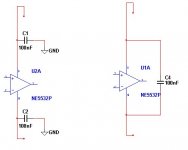In the second circuit you can still have supply ripple and noise on the supply lines that can get into the circuit. You can also still have coupling via the supply that can under circumstances lead to oscillations.
So you should always use the circuit 1, and then add circuit 2 if you want.
But it is important to get clean supplies referenced to the signal reference, and that normally is ground.
jan didden
So you should always use the circuit 1, and then add circuit 2 if you want.
But it is important to get clean supplies referenced to the signal reference, and that normally is ground.
jan didden
The second circuit does not deal with common-mode noise on the supply rails, but only differential-mode noise.
In the first circuit you will have only 50uF decoupling between pins 4 and 8.
Hi,
I can see that appears to be case but surely that is not the point if
the purpose of the decoupling is to decouple voltage rails to ground,
which it is I believe, rather than to each other, which it usually isn't.
As DF implies the second circuit has effectively 0uF for common mode.
The first circuit doesn't care about common / differential signals, and
as I understand it should always be used to guarantee stability.
I can't see the point of the second circuit.
rgds, sreten.
Since the PS supply caps, input, and output of the op-amp are referenced to gnd, so must the de-coupling caps or the circuit is not completed. IOW, the supply pins of the op-amp must have AC reference to gnd via the de-coupling along with the rest of the IC or instability may take place.
- Status
- Not open for further replies.
- Home
- Amplifiers
- Solid State
- What is difference between two circuits
